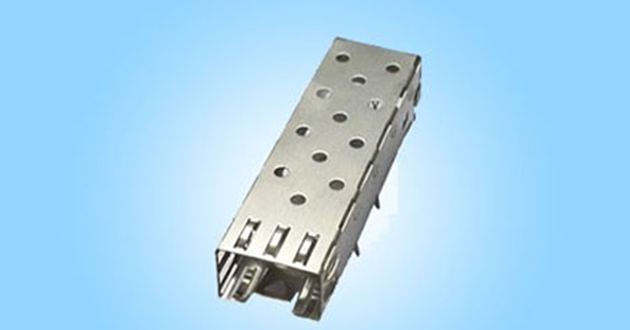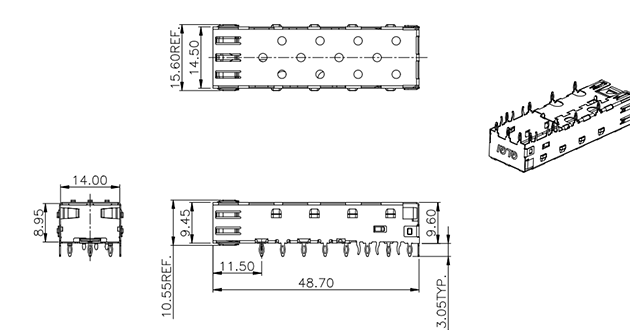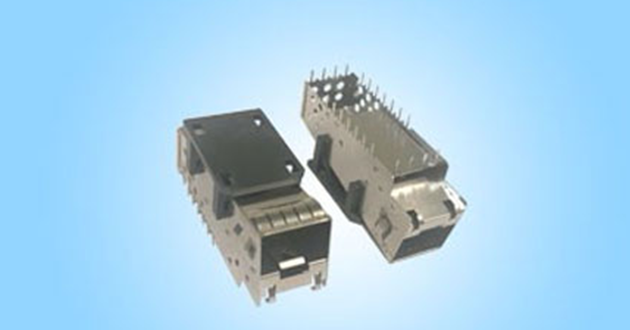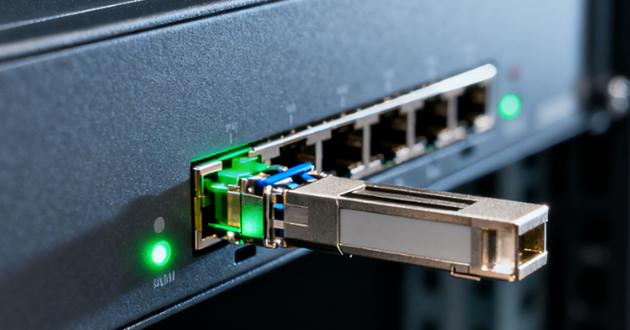This guide gives you a clear, practical map of the sfp connector landscape. We start with port types by speed—SFP/1G through SFP-DD/100G and the QSFP family—so you can match electrical capability (NRZ or PAM4, lanes, FEC) to the bandwidth you need.
Then we move into real-world functions and applications—SR/LR/ER/ZR, BiDi, CWDM/DWDM, RJ-45, DAC/AOC, Fibre Channel, telecom, PON, and industrial—showing how each sfp connector option fits distance, medium, and deployment constraints.

|
Type |
Lanes / Encoding |
Typical optics / cables |
Common uses |
Notes / compatibility |
|
SFP (1G) |
1×, 1000BASE-X (8b/10b) |
SX (MMF), LX/LR (SMF), RJ-45 SFP, short DAC |
Access uplinks, mgmt, legacy campus |
Often works in SFP+ cages (device-dependent) |
|
SFP+ (10G) |
1×, 10GBASE-R (64b/66b) |
SR/LR/ER/ZR, BiDi, DAC/AOC |
TOR↔aggregation, campus core, low-latency servers |
Many ports fall back to 1G with a 1G SFP |
|
SFP28 (25G) |
1×, 25GBASE-R (64b/66b) |
25G SR/LR, BiDi, 25G DAC/AOC |
Leaf–spine, dense server access |
Some ports downshift to 10G; FEC commonly required |
|
SFP56 (50G) |
1×, PAM4 (≈50G line rate) |
50G SR/LR, 50G DAC/AOC |
Higher-throughput access/leaf |
Needs host PAM4 support; not a drop-in for SFP28 |
|
SFP-DD (up to 100G) |
2× lanes; NRZ (25G/lane) or PAM4 (50G/lane) |
50G/100G SR/LR; DAC/AOC |
Dense 50G/100G at the edge |
Mechanically backward-friendly; actual host support varies |
|
QSFP+ / QSFP28 / QSFP56 |
4× lanes → 40G (4×10G NRZ) / 100G (4×25G NRZ) / 200G (4×50G PAM4) |
SR/LR, DAC/AOC; breakout harnesses |
Aggregation, spine, scalable uplinks |
Can break out to SFP families (e.g., 100G→4×25G) if platform supports |
Choose SFP ports by speed. For entry deployments, management ports, or legacy refreshes, pick SFP 1G (1000BASE-X, single lane)—it’s inexpensive and ubiquitous, and most SFP+ ports can run 1G. For 10G uplinks or low-latency server connects, use SFP+ 10G (10GBASE-R) while keeping 1G module compatibility for smooth migrations. To raise access or leaf–spine density, default to SFP28 25G (25GBASE-R); 25G links commonly enable FEC to meet BER targets, and some platforms can downshift to 10G. If you need 50G on a single lane, consider SFP56 (PAM4)—it requires host PAM4 support and isn’t a drop-in for SFP28. In each case, match the sfp connector (optic, DAC, or RJ-45) to the medium and distance you actually need.

For higher aggregation in the SFP footprint, choose SFP-DD (two lanes, 2×25G=50G or 2×50G=100G); coexistence with legacy SFP/SFP+/SFP28 depends on the device’s whitelist. At aggregation/backbone layers, the QSFP family is standard (QSFP+ 40G, QSFP28 100G, QSFP56 200G), and—where supported—you can break out 100G→4×25G or 40G→4×10G toward SFP ports. Before ordering, confirm port speed/encoding (NRZ or PAM4) and FEC support, then review the compatibility matrix, power draw, thermal headroom, and the exact sfp connector type your plant requires.
Run Ethernet over fiber by matching reach to the optic: use SR on MMF for in-row or same-floor links, LR on SMF for ~10 km, and ER/ZR for ~40/80 km when the link budget closes. Pair each sfp connector module with the right fiber grade (OM3/OM4 for SR, OS2 for LR/ER/ZR) and keep LC endfaces clean to avoid intermittent errors. On long single-mode paths, account for connector/splice loss and enable FEC where supported to maintain target BER.

A BiDi sfp connector carries TX/RX over a single strand using two wavelengths (e.g., 1270/1330 nm), ideal when conduit is constrained or you want to double capacity without new fiber. Both ends must use complementary BiDi parts—mismatched wavelengths won’t link. Expect a tighter power budget if you’re reusing older panels or jumpers.
CWDM/DWDM sfp connector modules multiplex multiple wavelengths on one fiber pair—common in metro/backhaul. CWDM offers wider spacing and simpler turn-ups; DWDM packs more channels but demands careful dispersion and power management (and sometimes amplification). Use the proper MUX/DEMUX and watch DOM/DDM trends to spot plant degradation early.
These sfp connector modules integrate a BASE-T PHY for Cat5e/6/6A at 1/2.5/5/10G (per model), letting you reuse copper plants or segment OT/management networks. Power draw and latency are higher than optics or DAC because of PHY DSP, so plan accordingly. For 10GBASE-T, stick to Cat6A and ≤100 m runs.

DAC (twinax) is the go-to for ultra-short, ultra-low-latency links (~1–5 m, sometimes ~7 m); check cable gauge for flexibility and reach. AOC covers tidy short–mid distances (~3–30 m) with easy routing and no fiber-cleaning routine. Both sfp connector cable options are favorites for server-to-ToR connections and keep front-of-rack cabling under control.
SFP/SFP+/SFP28 optics for 8/16/32G FC provide deterministic storage transport with the same hot-swap convenience as Ethernet. Align switch/NIC firmware, buffer credits, and speed settings when mixing generations. Optic choices mirror Ethernet (SR/LR), but FC fabrics are more sensitive to latency and loss—keep links short and clean.
Purpose-built sfp connector modules support SDH/SONET and OTN framing for sync-sensitive edge transport. Expect strict timing (e.g., SyncE/1588), defined alarm behavior, and management profiles that differ from Ethernet. Many parts target extended lifecycles and wider operating temperatures for telecom environments.

“PON-in-a-stick” ONU/OLT sfp connector modules embed the PON PHY so routers or media converters can terminate PON directly in an SFP slot—great for labs, CPE trials, or compact edge nodes. Verify optical power levels, splitter ratios, and vendor profiles to avoid interoperability surprises, especially in mixed-PON plants.
Hardened sfp connector optics and cages (often –40 °C to +85 °C) offer improved EMI immunity, shock resistance, and sealing for factories, outdoor cabinets, and transport. Look for conformal coating, positive-locking latches, and corrosion-resistant housings. In exposed runs, pair with armored or UV-rated patch cords to maintain reliability.

Conclusion
When choosing a sfp connector, decide the target speed first, confirm the port’s encoding and FEC support, and pick the medium that meets your reach (MMF/SMF/copper).